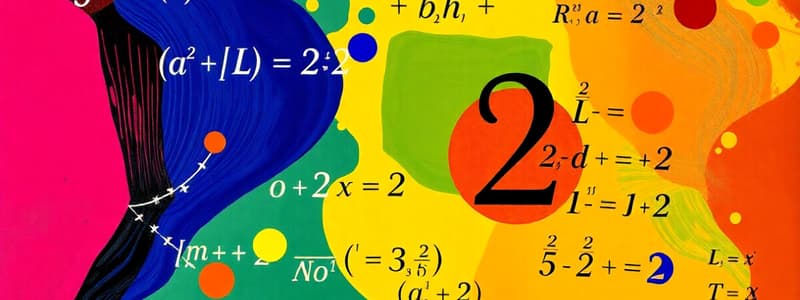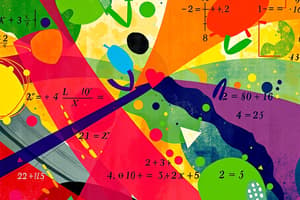Podcast
Questions and Answers
What is the primary purpose of the Remainder Theorem?
What is the primary purpose of the Remainder Theorem?
- To compute the integral of a polynomial
- To find the roots of a polynomial
- To evaluate the polynomial at a specific point (correct)
- To determine if a polynomial has factors
Which of the following equations represents a hyperbola?
Which of the following equations represents a hyperbola?
- (y - k)² - (x - h)²/a² = 1
- (x - h)²/a² - (y - k)²/b² = 1 (correct)
- (x - h)² + (y - k)² = r²
- (x - h)²/a² + (y - k)²/b² = 1
What defines a quadratic function?
What defines a quadratic function?
- y = ax² + bx + c (correct)
- y = ax^3 + bx + c
- y = mx + b
- y = a(b^x)
In what form are complex numbers expressed?
In what form are complex numbers expressed?
Which method of solving systems of equations involves using one equation to substitute into another?
Which method of solving systems of equations involves using one equation to substitute into another?
When solving a quadratic equation using the quadratic formula, what does the expression $b² - 4ac$ determine?
When solving a quadratic equation using the quadratic formula, what does the expression $b² - 4ac$ determine?
Which property of logarithms is correctly stated?
Which property of logarithms is correctly stated?
In an arithmetic sequence, the difference between consecutive terms is best defined as what?
In an arithmetic sequence, the difference between consecutive terms is best defined as what?
Flashcards are hidden until you start studying
Study Notes
Key Concepts in Algebra 2
1. Functions
- Definition: A relation where each input has exactly one output.
- Types:
- Linear Functions: y = mx + b
- Quadratic Functions: y = ax² + bx + c
- Polynomial Functions: Includes higher degrees (cubic, quartic, etc.)
- Rational Functions: Ratio of two polynomials.
- Exponential Functions: y = a(b^x)
- Logarithmic Functions: Inverse of exponential functions, y = log_b(x)
2. Equations and Inequalities
- Solving Linear Equations: Isolate the variable using inverse operations.
- Solving Quadratic Equations:
- Factoring
- Quadratic Formula: x = (-b ± √(b² - 4ac)) / 2a
- Completing the Square
- Inequalities: Solve and graph on a number line. Consider open and closed intervals.
3. Polynomials
- Operations: Addition, subtraction, multiplication, division (synthetic and long).
- The Remainder Theorem: When a polynomial f(x) is divided by (x - c), the remainder is f(c).
- The Factor Theorem: A polynomial f(x) has a factor (x - c) if f(c) = 0.
- Polynomial Long Division: Process for dividing polynomials similar to numerical long division.
4. Complex Numbers
- Form: a + bi, where a and b are real numbers, and i is the imaginary unit (i² = -1).
- Operations: Addition, subtraction, multiplication, and division of complex numbers.
5. Conic Sections
- Types:
- Circles: (x - h)² + (y - k)² = r²
- Ellipses: (x - h)²/a² + (y - k)²/b² = 1
- Parabolas: y = ax² + bx + c or x = ay² + by + c
- Hyperbolas: (x - h)²/a² - (y - k)²/b² = 1
- Focus and Directrix: Key properties for parabolas and other conics.
6. Systems of Equations
- Methods of solving:
- Graphing
- Substitution
- Elimination
- Types: Consistent (one solution), inconsistent (no solution), dependent (infinitely many solutions).
7. Sequences and Series
- Arithmetic Sequences: Difference between terms is constant.
- Geometric Sequences: Ratio between terms is constant.
- Sum formulas:
- Arithmetic Series: S_n = n/2 * (a_1 + a_n)
- Geometric Series: S_n = a * (1 - r^n) / (1 - r)
8. Probability and Statistics
- Basic probability: P(E) = number of favorable outcomes / total outcomes.
- Permutations: Arrangement of objects where order matters.
- Combinations: Selection of objects where order does not matter.
9. Exponential and Logarithmic Functions
- Properties of Exponents: Product, quotient, power rules.
- Logarithm Properties: log_b(mn) = log_b(m) + log_b(n); log_b(m/n) = log_b(m) - log_b(n); log_b(m^n) = n * log_b(m).
10. Matrices
- Definition: Rectangular arrays of numbers.
- Operations: Addition, subtraction, multiplication, and finding determinants.
- Applications: Solve systems of equations, transformations.
11. Trigonometry
- Definitions: Relationships between the angles and sides of triangles.
- Fundamental Identities: Pythagorean identity, sine and cosine laws.
- Graphs of Trigonometric Functions: Sine, cosine, tangent functions. Periodicity and amplitude concepts.
These concepts form the foundation of Algebra 2 and are essential for advanced mathematics disciplines.
Functions
- A function assigns exactly one output for each input.
- Linear functions represented as y = mx + b, where m is the slope and b the y-intercept.
- Quadratic functions take the form y = ax² + bx + c, characterized by a parabolic graph.
- Polynomial functions encompass all degrees, including cubic and quartic equations.
- Rational functions are the ratio of two polynomials, highlighting division of functions.
- Exponential functions follow the equation y = a(b^x), showcasing rapid growth or decay.
- Logarithmic functions are the inverses of exponential functions, denoted as y = log_b(x).
Equations and Inequalities
- Linear equations solved by isolating the variable with inverse operations.
- Quadratic equations can be solved through factoring, using the quadratic formula, or completing the square.
- Inequalities require solutions that are graphically represented on a number line, considering open (not included) and closed (included) intervals.
Polynomials
- Polynomial operations include addition, subtraction, multiplication, and division via synthetic or long methods.
- The Remainder Theorem states that the remainder of f(x) divided by (x - c) equals f(c).
- The Factor Theorem indicates that (x - c) is a factor of f(x) if f(c) equals zero.
- Polynomial long division resembles traditional long division processes.
Complex Numbers
- Complex numbers are expressed as a + bi, where i is the imaginary unit satisfying i² = -1.
- Operations on complex numbers include addition, subtraction, multiplication, and division.
Conic Sections
- Conic sections include circles, ellipses, parabolas, and hyperbolas with specific equations for each shape.
- Circles: (x - h)² + (y - k)² = r², centered at (h, k) with radius r.
- Ellipses: (x - h)²/a² + (y - k)²/b² = 1 with semi-major and semi-minor axes.
- Parabolas: y = ax² + bx + c or x = ay² + by + c indicating the curve orientation.
- Hyperbolas: (x - h)²/a² - (y - k)²/b² = 1 showcasing two separate curves.
- Focus and directrix are critical characteristics for understanding conic sections.
Systems of Equations
- Solutions can be found using graphing, substitution, or elimination methods.
- Systems can be classified as consistent (single solution), inconsistent (no solution), or dependent (infinitely many solutions).
Sequences and Series
- Arithmetic sequences feature a constant difference between consecutive terms.
- Geometric sequences exhibit a constant ratio between consecutive terms.
- Formulas for sums include:
- Arithmetic Series: S_n = n/2 * (a_1 + a_n).
- Geometric Series: S_n = a * (1 - r^n) / (1 - r), useful for series with a common ratio.
Probability and Statistics
- Basic probability is calculated as P(E) = favorable outcomes / total outcomes.
- Permutations consider arrangements where order matters.
- Combinations refer to selections where order does not impact the outcome.
Exponential and Logarithmic Functions
- Exponent properties include product, quotient, and power rules essential for simplification.
- Logarithm properties include rules for multiplication, division, and powers that aid in equation transformations.
Matrices
- Matrices are rectangular arrays of numbers used in various mathematical applications.
- Operations on matrices include addition, subtraction, multiplication, and determining determinants.
- Matrices are employed to solve systems of equations and facilitate transformations in geometry.
Trigonometry
- Trigonometry studies relationships between angles and sides in triangles.
- Fundamental identities include the Pythagorean identity and sine and cosine laws.
- Graphs of trigonometric functions (sine, cosine, tangent) demonstrate periodic behavior and amplitude variations, crucial for modeling cyclical patterns.
Studying That Suits You
Use AI to generate personalized quizzes and flashcards to suit your learning preferences.




